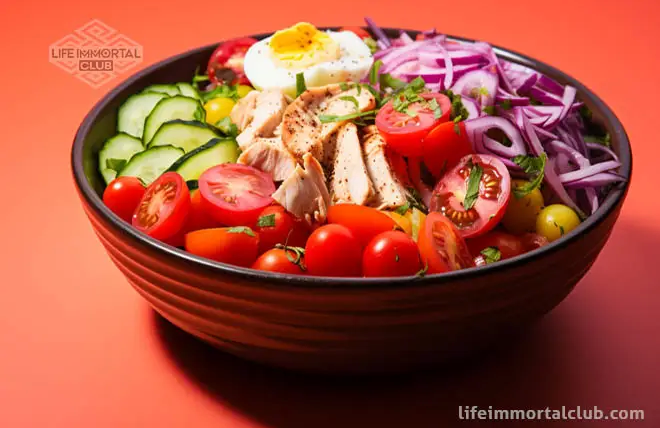Trying for the best $100/month Diet for 2 Adults

Table of Contents
- Benefits of a Healthy Diet
- Challenges of Eating Healthy on a Tight Budget
- Purpose of the Article
- Understanding Nutritional Requirements
- Planning Your Budget-Friendly Grocery List
- Cost-Effective Meal Planning Strategies
- Conclusion
Introduction
A healthy diet is the cornerstone of overall well-being, providing essential nutrients for optimal physical and mental functioning. However, with financial constraints often looming over our heads, it can be challenging to maintain a nutritious diet without breaking the bank. The aim of this article is to present a comprehensive guide on how to achieve the cheapest and healthiest diet under $100 per month for two adults, ensuring that no compromise is made on nutritional value or taste.
Benefits of a Healthy Diet
In today's fast-paced world, maintaining a healthy diet is often overlooked in favor of convenience and cost-saving measures.
Maintaining a healthy diet is not merely about weight management; it encompasses numerous benefits that positively impact our overall quality of life. A balanced diet provides essential macronutrients such as carbohydrates, proteins, and fats, which serve as the fuel for our bodies. These macronutrients are responsible for energy production, muscle growth and repair, and hormone regulation.
In addition to macronutrients, a healthy diet also emphasizes micronutrients - vitamins and minerals that play vital roles in supporting various bodily functions. Sufficient intake of these micronutrients helps boost immunity, promotes strong bones and teeth, aids in cognitive function, and supports normal cell development.
Here's a look at the key benefits:
10 Benefits of a Healthy Diet
- Weight Management: A healthy diet helps you maintain a healthy weight, reducing the risk of obesity and related health issues.
- Improved Heart Health: It lowers the risk of heart diseases by reducing cholesterol levels and controlling blood pressure.
- Better Digestive Health: A diet rich in fiber promotes regular bowel movements and prevents digestive problems.
- Enhanced Immunity: Proper nutrition boosts your immune system, helping your body fight off illnesses and infections.
- Increased Energy Levels: Nutrient-rich foods provide sustained energy throughout the day, reducing fatigue.
- Healthy Skin and Hair: A balanced diet contributes to clear skin, strong nails, and shiny hair.
- Improved Mental Health: It can reduce the risk of depression and anxiety while enhancing cognitive function.
- Reduced Risk of Chronic Diseases: A healthy diet lowers the risk of conditions like diabetes, cancer, and stroke.
- Stronger Bones and Teeth: Adequate intake of calcium and vitamins supports bone health and dental hygiene.
- Longevity: It can increase your lifespan and promote a higher quality of life in your later years.
Challenges of Eating Healthy on a Tight Budget
Eating healthily can be challenging when you're on a tight budget. Rising food prices and financial constraints often deter individuals from making nutritious choices. Unhealthy processed foods tend to be more affordable and convenient, making them a tempting choice. Lack of time and knowledge to prepare nutritious meals from scratch further compounds the problem.
These factors combined create significant barriers for individuals striving to maintain a healthy diet while on a tight budget.
Purpose of the Article
The purpose of this article is to provide you with a comprehensive guide on how to achieve a healthy diet on a strict budget of $100 per month for two adults. By addressing the challenges and offering practical solutions, we aim to empower you with the knowledge and resources needed to make informed decisions about your dietary habits.
Through careful planning, cost-effective shopping strategies, and creative meal ideas, it's possible to prioritize both health and affordability without sacrificing taste or variety. Let's explore how to navigate these challenges and create a nutritious, budget-friendly diet.
Understanding Nutritional Requirements
One key aspect of maintaining a healthy diet is understanding your body's nutritional requirements. Macronutrients, including carbohydrates, proteins, and fats, play crucial roles in providing energy and essential building blocks for bodily functions.
Macronutrients: Carbohydrates, Proteins, and Fats
Macronutrients are the building blocks of a healthy diet. Carbohydrates provide the primary source of energy for your body. They can be found in foods like grains, fruits, vegetables, and legumes. Complex carbohydrates, found in whole grains like brown rice and oats, offer sustained energy.
Micronutrients: Vitamins and Minerals
Micronutrients are essential for various bodily functions necessary for good health. Iron is crucial for oxygen transport and can be found in lean meats, legumes, leafy greens, and fortified cereals. Zinc supports the immune system and is sourced from meat, seafood, whole grains, and seeds. Vitamins like A and C are essential for vision, immunity, and collagen production. Carrots, sweet potatoes, citrus fruits, and strawberries are rich in these vitamins.
Planning Your Budget-Friendly Grocery List
Creating a budget-friendly grocery list involves incorporating staple foods that offer maximum nutrition at a minimum cost. Here are some cost-effective options:
List of healthy choice items and their (approximate) prices:
| Item | Price |
|---|---|
| Beef stew meat (1½ lbs.) | $15.00 |
| Eggs, organic (2 dozen) | $8.99 |
| Green bell peppers, organic (3) | $8.00 |
| Apples, organic (2 lbs., or about 5) | $6.20 |
| Canned wild salmon (6-oz. can) | $5.79 |
| Oatmeal (18-oz. container) | $5.39 |
| Natural peanut butter (16-oz. jar) | $5.39 |
| Almond milk (½ gallon) | $3.29 |
| Greek yogurt (32-oz. container) | $4.99 |
| Avocados (3) | $4.40 |
| Cilantro (1 bunch) | $1.19 |
| Canned tomatoes and chiles (10-oz. can) | $1.49 |
| Red onion (1 medium) | $1.50 |
| Canned diced tomatoes (28-oz. can) | $1.99 |
| Canned green chiles (4-oz. can) | $1.99 |
| Bananas (8) | $1.88 |
| Carrots (1-lb. bag) | $1.79 |
| Scallions (1 bunch) | $1.79 |
| Canned black beans (4 14.5-oz. cans) | $4.39 |
| Tomato juice (32-oz. can) | $4.59 |
| Sweet potatoes (4 medium) | $4.24 |
| Whole-wheat bread (1 loaf) | $4.29 |
| Whole-grain tortillas (1 package) | $4.09 |
| Baby spinach, organic (5-oz. box) | $3.79 |
| Blueberries (14-oz. bag) | $3.70 |
| Romaine lettuce (3 medium heads) | $3.49 |
| Sharp Cheddar cheese (8-oz. package) | $2.79 |
| Lentils, brown (1-lb. bag) | $2.69 |
| Green cabbage (1 medium head) | $4.76 |
| Heavy cream (½ pint) | $2.99 |
| Garlic (1 bulb) | $0.79 |
| Onion (1 medium) | $1.00 |
| Tomato paste (6-oz. can) | $1.19 |
| Celery, organic (1 bunch) | $3.50 |
Staple Foods: Whole Grains
Whole grains like rice, oats, and pasta are excellent choices. They retain fiber, vitamins, and minerals, which support digestive health and reduce the risk of chronic diseases. Buying them in bulk or opting for store-brand options can save you money.
Staple Foods: Legumes
Legumes, such as beans and lentils, are nutritional powerhouses that are both versatile and cost-effective. Packed with protein, fiber, iron, and other essential nutrients, they provide an excellent alternative to meat. Dried legumes are more affordable than canned varieties but require soaking and cooking time. Canned options offer convenience.
Cost-Effective Meal Planning Strategies
To make the most of your budget, consider these cost-effective meal planning strategies:
- Shop smart: Look for sales and seasonal produce, and stock up on cheap staples like eggs and canned tuna.
- Eat more plants: Use plant-based proteins like lentils and beans, which are cheaper and healthier than animal proteins
- Have theme nights: Assign different themes to each night based on meal types or pantry staples, and use leftovers creatively.
- Keep it simple: Choose easy breakfasts, snack-style lunches, and quick dinners that use the same ingredients in different ways.
Economizing Through Batch Cooking
Batch cooking involves preparing larger quantities of meals in advance and portioning them out. It saves time, energy, and money by buying ingredients in bulk. Dishes like stews, casseroles, and soups are ideal for batch cooking and can be frozen for later use.
Reducing Food Waste with Smart Planning
Minimizing food waste is crucial for your budget and the environment. Create a detailed meal plan before shopping to buy only what you need. Take inventory of items in your pantry and fridge to avoid waste. Repurpose leftovers creatively into new dishes and consider composting food scraps.
Eating Seasonally and Locally
Opt for seasonal and locally-grown produce to save money and enjoy fresher options. Seasonal fruits and vegetables are more affordable and taste better since they're harvested at their peak. Frozen fruits and vegetables are convenient and maintain their nutritional value. Look for weekly sales and discounts to maximize savings.
Conclusion
Eating a healthy diet on a tight budget is challenging but entirely possible with the right knowledge and strategies. By understanding your nutritional requirements, planning your grocery list smartly, and implementing cost-saving strategies, you can achieve a cheap and wholesome diet.
View this journey as an opportunity for creativity and resourcefulness rather than a limitation. With careful planning and culinary ingenuity, you'll not only save money but also improve your overall well-being. Remember that nourishing yourself doesn't have to break the bank – it can be an affordable and enjoyable experience!







